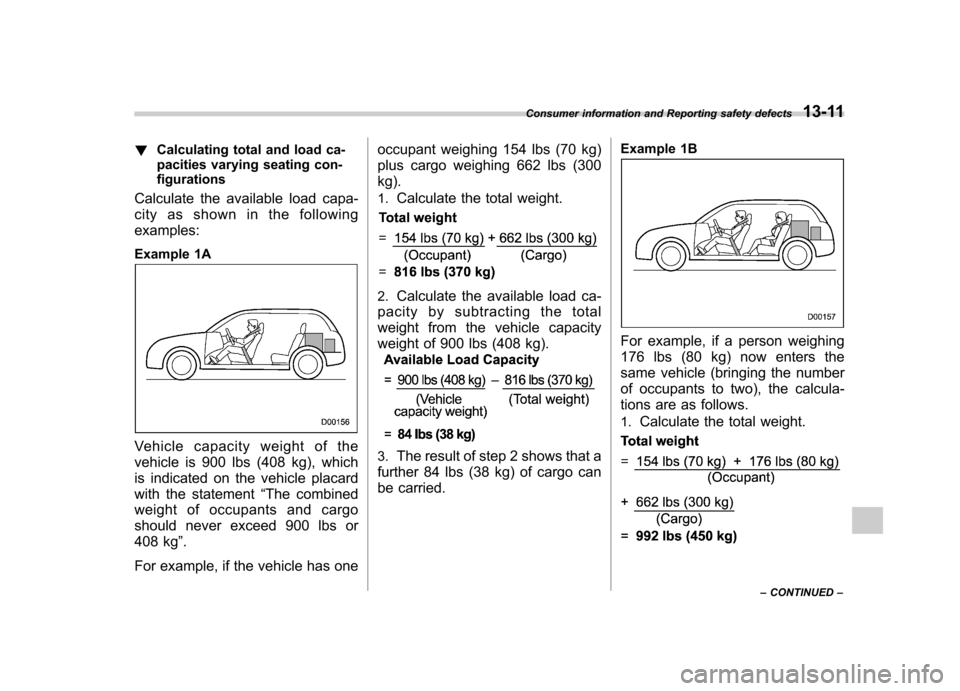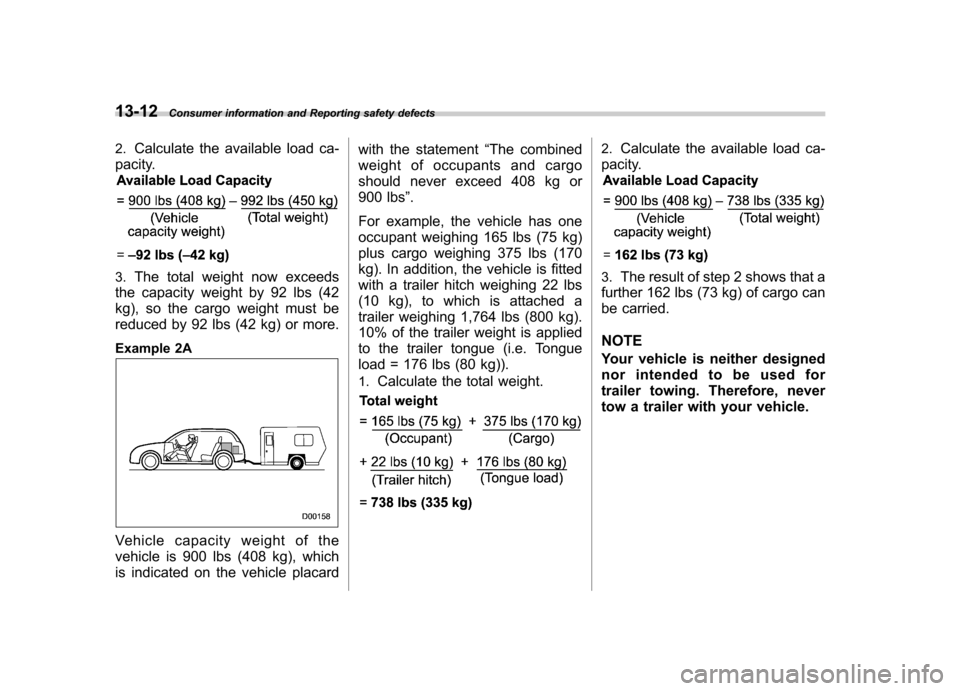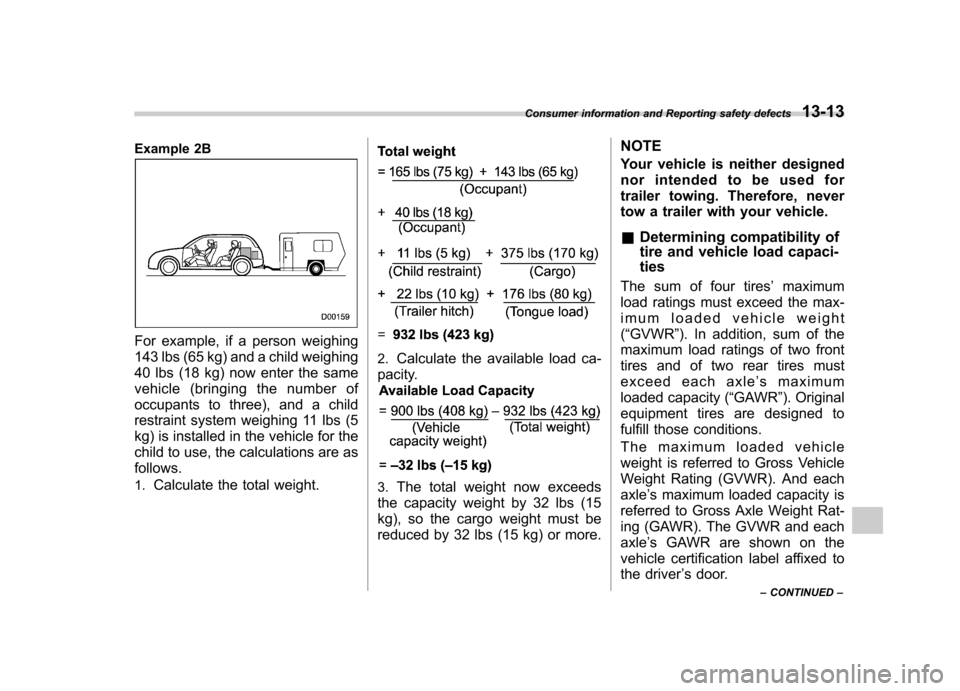2011 SUBARU IMPREZA WRX weight
[x] Cancel search: weightPage 440 of 458

!Calculating total and load ca-
pacities varying seating con-
figurations
Calculate the available load capa-
city as shown in the followingexamples:
Example 1A
Vehicle capacity weight of the
vehicle is 900 lbs (408 kg), which
is indicated on the vehicle placard
with the statement “The combined
weight of occupants and cargo
should never exceed 900 lbs or
408 kg ”.
For example, if the vehicle has one occupant weighing 154 lbs (70 kg)
plus cargo weighing 662 lbs (300 kg). 1.
Calculate the total weight.
2.Calculate the available load ca-
pacity by subtracting the total
weight from the vehicle capacity
weight of 900 lbs (408 kg).
3. The result of step 2 shows that a
further 84 lbs (38 kg) of cargo can
be carried. Example 1B
For example, if a person weighing
176 lbs (80 kg) now enters the
same vehicle (bringing the number
of occupants to two), the calcula-
tions are as follows. 1.
Calculate the total weight.
Consumer information and Reporting safety defects 13-11
– CONTINUED –
Page 441 of 458

13-12Consumer information and Reporting safety defects
2. Calculate the available load ca-
pacity.
3. The total weight now exceeds
the capacity weight by 92 lbs (42
kg), so the cargo weight must be
reduced by 92 lbs (42 kg) or more.
Example 2A
Vehicle capacity weight of the
vehicle is 900 lbs (408 kg), which
is indicated on the vehicle placard with the statement
“The combined
weight of occupants and cargo
should never exceed 408 kg or
900 lbs ”.
For example, the vehicle has one
occupant weighing 165 lbs (75 kg)
plus cargo weighing 375 lbs (170
kg). In addition, the vehicle is fitted
with a trailer hitch weighing 22 lbs
(10 kg), to which is attached a
trailer weighing 1,764 lbs (800 kg).
10% of the trailer weight is applied
to the trailer tongue (i.e. Tongue
load = 176 lbs (80 kg)).
1. Calculate the total weight.
2. Calculate the available load ca-
pacity.
3. The result of step 2 shows that a
further 162 lbs (73 kg) of cargo can
be carried. NOTE
Your vehicle is neither designed
nor intended to be used for
trailer towing. Therefore, never
tow a trailer with your vehicle.
Page 442 of 458

Example 2B
For example, if a person weighing
143 lbs (65 kg) and a child weighing
40 lbs (18 kg) now enter the same
vehicle (bringing the number of
occupants to three), and a child
restraint system weighing 11 lbs (5
kg) is installed in the vehicle for the
child to use, the calculations are as follows. 1.Calculate the total weight.
2.Calculate the available load ca-
pacity.
3. The total weight now exceeds
the capacity weight by 32 lbs (15
kg), so the cargo weight must be
reduced by 32 lbs (15 kg) or more. NOTE
Your vehicle is neither designed
nor intended to be used for
trailer towing. Therefore, never
tow a trailer with your vehicle. &
Determining compatibility of
tire and vehicle load capaci- ties
The sum of four tires ’maximum
load ratings must exceed the max-
imum loaded vehicle weight( “GVWR ”). In addition, sum of the
maximum load ratings of two front
tires and of two rear tires must
exceed each axle ’smaximum
loaded capacity ( “GAWR ”). Original
equipment tires are designed to
fulfill those conditions.
The maximum loaded vehicle
weight is referred to Gross Vehicle
Weight Rating (GVWR). And eachaxle ’s maximum loaded capacity is
referred to Gross Axle Weight Rat-
ing (GAWR). The GVWR and each axle ’s GAWR are shown on the
vehicle certification label affixed to
the driver ’s door.
Consumer information and Reporting safety defects
13-13
– CONTINUED –
Page 443 of 458

13-14Consumer information and Reporting safety defects
The GVWR and front and rear
GAWRs are determined by not only
the maximum load rating of tires but
also loaded capacities of the vehi-cle ’s suspension, axles and other
parts of the body.
Therefore, this means that the
vehicle cannot necessarily be
loaded up to the tire ’s maximum
load rating on the tire sidewall. & Adverse safety conse-
quences of overloading on
handling and stopping and
on tires
Overloading could affect vehicle
handling, stopping distance, and
vehicle and tire performance in the
following ways. This could lead to
an accident and possibly result in
severe personal injury. . Vehicle stability will deteriorate.
. Heavy and/or high-mounted
loads could increase the risk of
rollover. . Stopping distance will increase.
. Brakes could overheat and fail. .
Suspension, bearings, axles and
other body parts could break or
experience accelerated wear that
will shorten vehicle life.
. Tires could fail.
. Tread separation could occur.
. Tire could separate from its rim.
& Steps for Determining Cor-
rect Load Limit
1. Locate the statement “The com-
bined weight of occupants and
cargo should never exceed XXXpounds ”on your vehicle ’s placard.
2. Determine the combined weight
of the driver and passengers that
will be riding in your vehicle. 3. Subtract the combined weight of
the driver and passengers from
XXX kilograms or XXX pounds. 4. The resulting figure equals the
available amount of cargo and
luggage load capacity. For exam-
ple, if the “XXX ”amount equals
1,400 lbs (635 kg) and there will be
five- 150 lbs (68 kg) passengers in
your vehicle, the amount of avail- able cargo and luggage load capa-
city is 650 lbs. (1,400
�750 (5 6
150) = 650 lbs)
5. Determine the combined weight
of luggage and cargo being loaded
on the vehicle. That weight may not
safely exceed the available cargo
and luggage load capacity calcu-
lated in Step 4. 6. If your vehicle will be towing a
trailer, load from your trailer will be
transferred to your vehicle. Consult
this manual to determine how this
reduces the available cargo and
luggage load capacity of your ve-hicle. NOTE
Your vehicle is neither designed
nor intended to be used for
trailer towing. Therefore, never
tow a trailer with your vehicle.
Page 450 of 458

Exhaust gas (carbon monoxide)............................. 6, 8-2
Hood .................................................................... 11-5
Oil............................................................... 11-10, 12-5 Overheating .......................................................... 9-13
Starting ................................................................... 7-9
Stopping ............................................................... 7-10
Exterior care .............................................................. 10-2
F
Flat tires ..................................................................... 9-6
Floor mat .................................................................. 6-11
Fluid level Automatic transmission .......................................... 11-22
Brake .................................................................. 11-25
Clutch .................................................................. 11-26
Power steering ..................................................... 11-24
Fog light
Bulb .................................................................... 11-50
Indicator light ......................................................... 3-27
Switch .................................................................. 3-36
Folding mirror switch .................................................. 3-48
Front Differential gear oil ........................................ 11-23, 12-8
Fog light ...................................................... 3-36, 11-50
Fog light indicator light ............................................ 3-27
Seatbelt pretensioners ............................................ 1-19
Turn signal light .................................................... 11-50
Front seats .................................................................. 1-2
Active head restraint ................................................. 1-5
Forward and backward adjustment ............................. 1-3
Head restraint adjustment ......................................... 1-4 Reclining
................................................................ 1-3
Seat cushion height adjustment ... .............................. 1-4
Fuel ........................................................................... 7-3
Consumption indicator ............................................. 3-29
Economy hints ........................................................ 8-2
Filler lid and cap ...................................................... 7-4
Gauge ................................................................... 3-10
Requirements ................................................. 7-3, 12-4
Fuses ..................................................................... 11-45
Main fuse ............................................................ 11-46
Fuses and circuits .................................................... 12-12
G
GAWR (Gross Axle Weight Rating) .. ............................. 8-13
Glove box ................................................................... 6-5
GVWR (Gross Vehicle Weight Rating) ........................... 8-13
H
Hands-free system. ..................................................... 5-46
Hazard warning flasher .......................................... 3-5, 9-2
Head restraint adjustment
Front seat ............................................................... 1-4
Rear seat ............................................................... 1-8
Headlight Beam leveler. ......................................................... 3-34
Bulb replacement ................................................. 11-47
Bulb replacing ...................................................... 11-47
Bulb wattage ........................................................ 12-16
Control switch ........................................................ 3-31
Flasher .................................................................. 3-32
Indicator light ......................................................... 3-27 Index
14-5
Page 455 of 458

14-10Index
Tilt/telescopic ......................................................... 3-50
Stopping the engine ................................................... 7-10
Storage compartment ................................................... 6-4
Sun shade ................................................................ 2-30
Sun visors ................................................................... 6-4
Supplemental Restraint System airbag (SRS) ................ 1-35
Synthetic leather upholstery ........................................ 10-5
T
Tachometer ................................................................. 3-9
Temperature gauge .................................................... 3-11
Temperature warning light AT OIL TEMP ........................................................ 3-18
Coolant ................................................................. 3-17
Rear differential oil ................................................. 3-19
Temporary spare tire .................................................... 9-2
Tether (child restraint system) .............................. 1-29, 1-31
Tie-down hooks ......................................................... 9-14
Tire ............................................................... 11-31, 12-11
Chains .................................................................. 8-11
Inspection ............................................................ 11-33
Pressures and wear .............................................. 11-33
Replacement ........................................................ 11-37
Rotation ............................................................... 11-36
Size and pressure ................................................. 12-11
Types .................................................................. 11-31
Tire pressure monitoring system (TPMS). .... 7-38, 9-10, 11-31
Warning light ......................................................... 3-19
Tires and wheels. ...................................................... 11-31
Tools .......................................................................... 9-4
Top tether anchorages ........................................ 1-29, 1-31 Towing
...................................................................... 9-14
All wheels on the ground ......................................... 9-17
Flat-bed truck ......................................................... 9-17
Hooks ................................................................... 9-14
Trailer Towing .................................................................. 8-15
Trip meter ................................................................... 3-8
Trunk lid .................................................................... 2-25
Release handle ...................................................... 2-25
Trunk light ............................................................... 11-55
Turn signal
Indicator lights ........................................................ 3-26
Lever .................................................................... 3-33
U
Under-floor storage compartment .................................. 6-14
USB storage device operations .................................... 5-37
V
Valet mode ................................................................ 2-19
Vanity mirror ............................................................... 6-4
Vehicle Capacity weight ...................................................... 8-12
Identification ........................................................ 12-19
Symbols .................................................................... 3
Vehicle Dynamics Control
Mode switch .......................................................... 7-36
OFF indicator light .................................................. 3-23
OFF switch ............................................................ 7-37
Operation indicator light ........................................... 3-23
System .................................................................. 7-34